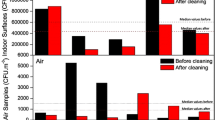Abstract
The choice of culture media when performing exposure assessment for mold quantification is difficult since no standard methods exist and, in many cases, there is no way to predict, before hand, the mold population present and thus, select the most appropriate media. The aim of this project was to compare the efficiency and usefulness of 3 widely used culture media during the recovery of molds in sawmills. Andersen microbial samplers (AMS) and all-glass impingers-30 (AGI-30) were used to sample 51 work sites within 17 sawmills. Rose Bengal Agar (RBA), Czapek Solution Agar (CZA) and Sabouraud Dextrose Agar (SDA) were used directly in AMS and to plate AGI-liquid. The results show that there was no signification difference between the three culture media concerning the counts and the species recovery. However, SDA often lead to non usable counts. The variations obtained with the different culture media when AGI-30 were plated in triplicate was also not significantly different. However, only 19% of the species recovered at one site were present on all culture media. We believe the use of various media increases the chances of obtaining valid counts and an adequate species recovery.
Similar content being viewed by others
References
Andersen A.A.: 1958, New sampler for the collection, sizing and enumeration of viable inhaled particles. J Bacteriol 67, 471-484.
Berstein R.S., Sorenson W.G., Garabrant D., Reaux C. and Treitman R.D.: 1983, Exposures to respirable, airborne Penicillium from a contaminated ventilation system: clinical, environmental and epidemiological aspects. Am Ind Hyg Assoc J 44, 161-169.
Burge H.A., Chatigny M., Feeley J., Kreiss K., Morey P., Otten J. and Peterson K. 1987, Guidelines for assessment and sampling of saprophytic bioaerosols in indoor in the indoor environment. Appl Ind Hyg 2, R10-R16.
Clark S., Rylander R. and Larsson L.: 1983, Airborne bacteria, endotoxin and fungi in dust in poultry and swine confinement buildings. Am Ind Hyg Assoc J 44, 537-541.
Comtois P. and Marcoux N.: 1999, An indoor air model. Aerobiologia 15, 115-120.
Duchaine C., Mériaux A., Brochu G. and Cormier Y.: 1999, Airborne microflora in Quebec dairy farms: Lack of effect of bacterial hay preservatives. Am Ind Hyg Assoc J 60, 89-95.
Duchaine C., Mériaux A., Thorne P.S. and Cormier Y.: 2000, Assessment of particulates and bioaerosols in Eastern Canada sawmills. Am Ind Hyg Assoc J 61, 727-732.
Duchaine C. and Mériaux A: 2000, Airborne Microfungi from Eastern Canadian Sawmills. Can J Microbiol 46, 612-617.
Eduard W., Lacey J., Karlsson K., Palmgren U., Ström G. and Blomquist G.: 1990, Evaluation of methods for enumerating microorganisms in filter samples from highly contaminated occupational environments. Am Ind Hyg Assoc J 51, 427-436.
Klich M.A. and Pitt J.I.: 1994, A Laboratory Guide to Common Aspergillus Species and Their Teleomorphs. Commonwealth Scientific and Industrial Research Organization, Division of Food Processing, North Ryde, Australia.
Lacey J. and Dutkiewicz J.: 1976, methods for examining the microflora of mouldy hay. J Appl Bacteriol 41, 13-27.
Larone D.H.: 1995, Medically Important Fungi. A Guide to Identification, 3rd edn. ASM Press, Washington DC.
May K.R. and Harper E.J.: 1957, The efficiency of various liquid impinger samplers in bacterial aerosols. Br J Ind Med 14, 287-297.
Nielsen B.H. and Breum N.O.: 1995, Exposure to air contaminants in chicken catching. Am Ind Hyg Assoc J 56, 804-808.
Overberger P.A., Wadowsky R.M. and Schaper M.M.: 1995, Evaluation of airborne particulates and fungi during hospital renovation. Am Ind Hyg Assoc J 56, 706-712.
Pitt J.I.: 1979, The Genus Penicillium and Its Teleomorphic States Eupenicillium and Talaromyces. Academic Press, New York.
Samson R.A., Hoekstra E.S., Frisvad J.C. and Filtenborg O.: 1996, Introduction to Food-Borne fungi. Centraalbureau Voor Schimmelcultures, The Netherlands.
Smid T., Schokkin E., Boleij J.S.M. and Heederick D.: 1989, Enumeration of viable fungi in occupational environments: A comparison of samplers and media. Am Ind Hyg Assoc J 50, 235-239.
St-Germain G. and Summerbell R.: 1996, Champignons filamenteux d'intérêt médical. Star Publishing Company, Belmont.
Wang C.J.K. and Zabel R.A.: 1990, Identification Manual for Fungi from Utility Poles in the Eastern United States. American Type Culture Collection, Lawrence, Kansas. Collection.
Author information
Authors and Affiliations
Corresponding author
Rights and permissions
About this article
Cite this article
Duchaine, C., Mériaux, A. & Comtois, P. Usefulness of using three different culture media for mold recovery in exposure assessment studies. Aerobiologia 18, 245–251 (2002). https://doi.org/10.1023/A:1021369530275
Issue Date:
DOI: https://doi.org/10.1023/A:1021369530275




